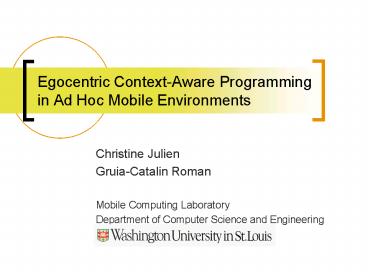Egocentric Context-Aware Programming in Ad Hoc Mobile Environments - PowerPoint PPT Presentation
1 / 19
Title:
Egocentric Context-Aware Programming in Ad Hoc Mobile Environments
Description:
Egocentric Context-Aware Programming. in Ad Hoc Mobile Environments. Christine Julien ... Scalable and extensible middleware for ad hoc mobile coordination ... – PowerPoint PPT presentation
Number of Views:36
Avg rating:3.0/5.0
Title: Egocentric Context-Aware Programming in Ad Hoc Mobile Environments
1
Egocentric Context-Aware Programming in Ad Hoc
Mobile Environments
- Christine Julien
- Gruia-Catalin Roman
- Mobile Computing Laboratory
- Department of Computer Science and Engineering
2
Outline
- Motivation
- View Concept
- Declarative View Specification
- View Operations
- EgoSpaces Middleware
- Conclusions
3
Motivation and Goals
- Environmental adaptation
- Continuous and rapid reactions
- Novel notion of context
- Extended in scope beyond the local host
- Application specific context definition
- Generalized treatment of context types
- Formal treatment of context-awareness
- Middleware for context management
- Provide general mechanisms for programming
4
Computational Model
- Hosts
- Agents
- Tuple spaces
- Tuples
5
Application Example
6
View Concept
- Egocentric
- Abstraction of a particular reference agents
operating context, specific to its needs - Multiple views
- Projection of all that is available
- Allow agent to control scope of views
- Facilitate easy program development
- Minimize performance penalties
7
View Presentation
- Context-sensitive data structures
- Tuple space provides coordination basis
- Veneers present other interactions
- Address different agents needs
- Cater to programmer expertise
Tree Presentation
Priority List Presentation
Tuple Space Representation
8
Coordination Services
- High-level veneers for sophisticated context
maintenance - Context-sensitive references
- Context-sensitive bindings
- Context-sensitive events
9
Declarative View Specification
- Specification
- Controls scope and size of view
- All location data owned by collision warning
agents on cars within 100 meters of my current
location - Implementation
- Automatic sensing
- Transparent maintenance
10
View Specification Network and Host Constraints
- Extend availability of context information
- Subnet based on abstraction of network topology
and its properties - within 100 meters
- Select hosts based on their properties
- cars
11
View SpecificationAgent and Data Constraints
- Restrict the set of application agents that
contribute to the view - collision warning agents
- Allow reference agent to restrict which data
items are available in the view - location data
12
Consistency Concerns
- Transactional semantics (e.g., money transfers)
- Strong application guarantees
- Can be expensive
- Best-effort semantics (e.g., traffic
conditions) - Variety of possible implementations
- Application chooses implementation to use based
on its particular situation
13
Access Controls
- Agent specified access control function
- Limits access of other agents to an agents data
- Reference agent provides credentials and intended
operations - Used by contributing agents access control
functions
14
Reactive Programming
- Agents adapt behavior in response to presence of
certain tuples - Associates an application-level reaction to the
appearance of a tuple in a view - Scheduling modality
- Eager or lazy semantics
15
Active Views
migrate
- Common built-in behaviors on views
- Transparent data migration
- Automatic duplication
- Event capture
- Extensibility
16
EgoSpaces Demo Application
17
Contributions
- General treatment of context
- Current applications tend to use only basic types
of context information in specific ways (e.g.,
location) - Guide tools, field work tools
- Extended scope of context
- Current frameworks and toolkits provide access
only to a single components sensors - Context Toolkit, Context Fabric
- Scalable and extensible middleware for ad hoc
mobile coordination - Current middleware provides either only local
interactions or symmetric and transitive
interactions - LIME, MARS
18
Conclusions and Future Work
- Novel coordination model
- Asymmetric interactions cater to individual
agents needs - As expressive as many other models (e.g., LIME,
Linda, JEDI, SIENA) - Flexible and general middleware
- Simplify programming for ad hoc environment
- Full implementation to include network
abstractions and reactive and active views - Evaluation through application examples
19
Thank You
- For more information
- http//www.cse.wustl.edu/mobilab
























![[AD Hoc Networks] PowerPoint PPT Presentation](https://s3.amazonaws.com/images.powershow.com/8371435.th0.jpg?_=20161231113)






